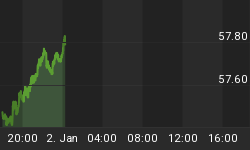Friday's sell-off in stocks and bonds, which surprised quite a few people, was ascribed to a growing economy that had low 4.7% hypothetical unemployment rate and created 211,000 hypothetical non-farm payrolls. Investors feared such prosperity might compel the inflation fighting Federal Reserve to raise rates higher to stave off inflation. I'll get to the surprise factor later. For now, fundamentally, my Competitive Tightening thesis clarifies that inflation data are the wrong places to look for all the wrong reasons behind the Fed's rate hike, and, technically, the sell-off was due to happen anyway notwithstanding the "old" employment news that occurred in the past month.
Prior to Friday's sell-off, a peculiar Nasdaq technical pattern had been forming since March 14, 2006, the day the crossover (blue arrow on Chart 1) of the green and the red DMIs (Directional Movement Indices) took place. After the crossover, the Nasdaq went on to new highs not seen since May 2001. The black ADX (Average Directional Index) line began a decisive move upward and the red -D began a decisive decline that eventually took the -D below the ADX and then below 10. Meanwhile, the green +D was going directionless - sideways (blue rectangular box).

Chart 1
J. Welles Wilder's DMIs measure price changes RELATIVE to the true range of the price movement. And, the ADX is the moving average of the difference between the two DMIs. The stronger the moves, be it up or down, the higher the ratios. Strong price uptrend is usually accompanied by a rising ADX, which is caused by expanding gap between the rising +D and the falling -D. November's rally was a good example of such action (black double arrows). Conversely, a strong downtrend's normally accompanied by a rising ADX that's caused by expanding gap between a rising -D and a falling +D.
I don't think this is how J. Welles Wilder intended for his brilliant indicator to be deciphered, but the easiest way to conceptualize the suite of the ADX indicators is to look at them as our traveling itineraries. For example, during our trip to northern California from southern California, we put 100 miles on our car driving around all day but, due to running errands or having a 3-martini lunch with an old friend, end up staying at this friend's house, which is 30 miles south of the hotel we're staying. Even though we've moved around in good range today, we've not advanced towards the direction of our final destination. In fact, we're now 30 miles behind. The positive DM (directional movement) for the day would then be zero while the negative DM would be 30 (30/100).
When the ADX began to rise in the 3rd week of March, it means that the difference between the D+ and the D- began to expand again. This time, however, the sideway bound +D had little to do with the rising ADX. Instead, the rising ADX was mostly boosted by a falling -D.
Using our conceptualization scheme, our trip up north is now in a stronger trending mode, not because we're making any significant advancement in distance, but because we're not going in the opposite direction (south) as often and as much as we used to be. Nonetheless, this kind of inefficient traveling itinerary would eventually get us so exhausted that we may never make it to our final destination. We may want to just go home. And, that's what's going to happen to the market eventually. Without significant positive price changes relative to the true range of price movement, the market is going to get so exhausted that it would eventually want to go back down south. The only question is that eventuality may yet to come.
While Friday's action has made a solid case for the bears, the surprise factor indicates that a lot of investors were still not believers of a market on the verge of exhaustion. One of my readers informed me via email that he was surprised to read my bearish analysis because one of his paid subscriptions advised him that the market's breaking out. This surprise factor could clearly be seen in the unchanged trading volume (Chart 2).
Unchanged volume, to me, is the sign of uncertainty. The higher the unchanged volume, the higher the degree of uncertainty. The mean (average) of the year-to-date daily unchanged trading volume is 1.9% (red horizontal line). This represents the typical unchanged volume on any given trading day. After the 9-day SMA of the Nasdaq's unchanged volume reverted to this mean from the March 13 low, it had been hovering around this average. This indicates little uncertainty about the recent Nasdaq uptrend that also started on March 13. Most investors seemed confident that this recent upswing was the real deal. This is why Friday's sell-off resulted in 5.19% unchanged trading volume, which was the 3rd highest of the year.

Chart 2
The sudden surge of unchanged volume (173% of the mean) on Friday seemed like a deer caught in the headlight. Many investors were stunned by the abrupt sell-off and didn't know how to react to it. They're waiting for further confirmation to make their moves. And unless there's follow-through sell-off this week to confirm the change of market direction, investors are likely to stay in the market. The market is likely to bounce back, but it's only going to get more exhausted from all the driving around.















